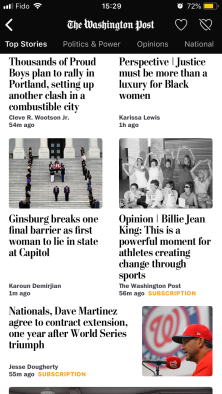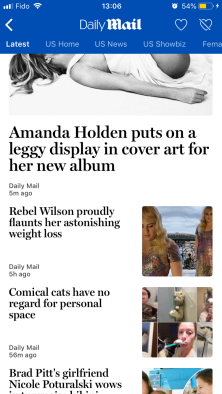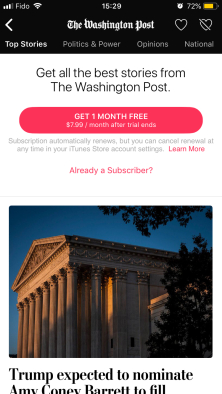
Oprah Winfrey best summed up the advantages of having your content feature prominently on iPhones when speaking at an Apple event in March 2019. “They’re in a billion pockets, y’all – a billion pockets,” she said, while promoting the launch of services including Apple News+ and Apple TV+.
It might therefore seem like a no-brainer for publishers to want their content to be made available on Apple News – which claims to be read by 125m people a month – or its paid-for sister app, Apple News+.
But this does not seem to be the case. Both the New York Times and the Washington Post turned down the opportunity to become Apple News+ partners when the paid-for app launched in 2019. And the former this year ditched Apple News altogether.
Other major publications make themselves unavailable in countries where they are already well established. Mail Online, for example, is not accessible on Apple News in the UK, but is available for users in the US, Canada and Australia. The Guardian was part of Apple News’s original launch in the UK, but has now removed itself from the platform, preferring to interact with readers on its own website or app. The Guardian is currently available on Apple News in the US.
The vast majority of big publishers do currently make their content available on Apple News. But one industry boss spoken to by Press Gazette predicts that some could start to follow the New York Times out of the door as publishers start to get more selective about which platforms they work with.
Here, in the first of a new series called Platform Profiles, Press Gazette takes an in-depth look at Apple News and Apple News+. We examine the pros and cons of the app, and seek to determine which publishers benefit from Apple News/ Apple News+, and which don’t.
The basics
The app’s homepage looks similar to many other news apps, with a list of articles and associated photographs that are available to click on (see screenshot below). Apple News was launched in 2015 to replace Newsstand on iPhones and iPads. The app is automatically downloaded and available on iPhones and iPads in the US, UK, Canada and Australia.
The homepage is edited by Apple’s in-house editors, who pick from articles that are submitted by partner publishers. Signed-up publishers choose how many articles they want to publish on any given day.
Away from the homepage, users are able to ‘follow’ topics or publications through the app, with an option to be sent notifications on their devices about important stories from these sources. Publishers each have their own page featuring articles they have chosen to put on the platform.


Apple News homepage (left) and Mail Online’s page within Apple News (right)
The free app also promotes content from Apple News+. When clicking on these articles, users are invited to try the premium product.
Apple News+ was launched last year after more than 300 publications were signed up as partners. The service costs users $9.99 a month in the US, £9.99 in the UK, CAD$12.99 in Canada and AUD$14.99 in Australia.
Subscribers are given access to all or most of the content produced by outlets that are signed up as Apple News+ partners. The app also features full editions of participating magazines.
Who are the publishers?
Thousands of publications across the US, UK, Canada and Australia make some of their content available on Apple News. The company declined to provide a total figure.
Most of the world’s largest English-language news outlets have content available through the app.
Some of the biggest names include: the Washington Post, Mail Online, the Guardian, BBC News, CNBC, CNN, Business Insider, Hollywood Reporter, Sky News, the Sun, the Telegraph, Reuters, Wired, Bloomberg, HuffPost, the Rolling Stone, Yahoo! News and Axios.
However, not all of these publications are available across all four countries. Mail Online, for example, is unavailable in the UK, but is present across Apple News platforms in the US, Canada and Australia.
Apple News+ says it has more than 300 publisher partners across the four countries in which it is operational.
The premium app is mainly magazine-focused, with participating titles including the Atlantic, BloombergBusinessweek, Town & Country, Billboard, Cosmopolitan, People, Elle and Harper’s Bazaar.
Newspapers available on Apple News+ include the UK’s Times and Sunday Times, the Wall Street Journal, the Los Angeles Times, the Kansas City Star, the Miami Herald, the San Diego Union-Tribune and Canada’s Globe and Mail.
How it works for publishers
Publishers interested in having their content feature on Apple News can apply through its News Publisher application.
Once approved, publishers can make use of Apple’s tools to create a ‘channel’ within the app that is consistent with their branding.


Left, the Times on Apple News. Right, the Times iPhone app
Publications then choose online articles that they would like to make available on the Apple News app. For those signed up to Apple News+, the vast majority of their content goes on to the app.
Publishers have the option of uploading articles in Apple News Format (ANF), which can be done through existing content management systems, or through an RSS feed, which can update automatically.
Apple’s in-house editors, who work closely with publishers, then decide which content to give maximum exposure to on their curated homepage.
Apple gives signed-up publishers access to a large array of user analytics. Publications are given stats on unique viewers, total views, average active times, shares, saves and new followers, as well as information about reader ages and genders.
Show me the money
Publishers can enable adverts – display, video or native – to appear on their Apple News channels and articles.
Publications keep 100% of the revenue generated from adverts that they sell themselves, and 70% when Apple sells the ads for them.
Apple offers news companies the use of its online ad management tool, Workbench, to create and manage campaigns, and to review performance.
News websites that have paywalls, like the Washington Post (see below), can sell subscriptions directly through the Apple News app.


How the Washington Post sells subscriptions using Apple News
Publishers signed up to Apple News+ share in revenues generated from user subscriptions.
The pros
“The traffic is incredible,” says David Chavern, chief executive of the News Media Alliance, which represents publishers across the United States.
In early 2020, Apple revealed that its News app was attracting 125m unique monthly users.
And as Oprah Winfrey’s “a billion pockets, y’all” comment highlights, this number is likely to grow.
For many publishers, the free Apple News app presents a big opportunity to reach new readers who might not otherwise come across their brand.
Apple News+ partners appear to be enjoying greater exposure to new readers also.
Robert Thompson, chief executive of News Corp – which owns News+ participants the Wall Street Journal and the Times – said in August that the partnership was proving a “beneficial experience”.
Speaking on an investor call, he said Apple News+ “allows us to focus on that tier of content and bring in a significantly new audience that we would hope to graduate to a paid WSJ subscription over time. And it is a genuinely different audience. It’s actually, of late, more women than men. For the Wall Street Journal itself, it’s more men than women. It’s a younger demographic. And it is obviously a source of potential subscribers for us.”
It is early days for Apple News+, and so revenues from subscriptions are likely to be modest currently. But Los Angeles Times executive editor Norman Pearlstine is hopeful that these are likely to grow in the future.
He recently said: “We are pleased with the results to date from Apple News+. We are learning about the information needs of a large audience that appreciates our original, important and surprising content. The financial results to date are consistent with our expectations. We are optimistic that they will continue to grow in the months and years ahead.”
The cons
The traffic may be “incredible”, says Chavern of the NMA, but “Apple restricts the ad units that can be sold around it. So it’s particularly good at driving traffic and particularly bad at driving money.”
Apple is said to restrict the types of ad units that can be used on News, and that this can result in less profitable adverts. Another complaint of publishers is that campaigns that work on Apple News are often difficult to integrate with other ad technology.
These issues were confirmed by another news industry insider spoken to by Press Gazette. Having your work on the free version of Apple News is a good way of reaching millions of eyeballs, but it’s difficult to make any immediate money from them.
Chavern also suggested that publishers may become less interested in Apple News as they switch their focus from attracting large numbers of readers to finding loyal readers who will pay to subscribe to them.
The most telling sign of issues with the set-up of Apple News came in late June when the New York Times ditched the app, saying it “does not align with our strategy to fund quality journalism by building direct relationships with paying readers.
“We believe quality publishers should be fairly compensated for the expensive proposition of creating and providing platforms valuable independent journalism.”
Expanding on this explanation on a recent investor call, NYT chief executive Meredith Kopit Levein said: “The decision is consistent with the core principles we have adopted in how we engage with the platforms: that quality news publications must be named and differentiated from other sources, that the end customer relationship and data should belong to publishers, and that the original creator of the content must be sufficiently compensated for its work.”
As referenced above, Apple also failed to sign up New York Times and Washington Post up to its News+ app.
Before launch, several media and technology commentators were critical of Apple’s plan to take around half of News+ subscription revenues and split the rest between publishers depending on their performance.
One described this proposal as “nuts”, and another said: “Apple’s approach seems to designed to ensure that the company makes the absolute most it can get away with.”
Apple recently caused a stir when it emerged that a new setting on its devices was diverting online traffic from its News+ publishing partners to its own app. The move risks upsetting relations between the US tech giant and the select group of news companies whose content is available on the premium Apple News+ app.
Reports in the US have also suggested that, after signing up 200,000 subscribers within 48 hours, Apple was struggling to build up a larger base of paying customers.
Speaking in November last year, Conde Nast chief executive Roger Lynch said the “jury is out”. “I hope Apple News+ is wildly successful,” he told the Code Media conference. “Whether it’s good for publishers like us or not is to be determined.”
Apple News: The verdict
With 125m readers a month, the free version of Apple News is clearly a good tool for newsgroups seeking to reach new and large audiences. However, it is currently difficult for partners to make good money out of this arrangement.
David Chavern of the NMA predicts that in the coming months and years, publishers will follow the New York Times in leaving Apple News and other aggregation services when they no longer fit with their business models.
“What you are seeing now is just people spraying content in a lot of different places to see what works best, to figure out what actually makes the most sense,” he said.
“The New York Times, as in many things, was really the first to say: ‘Okay, we’re going to be choosey n0w, we’re going to back off and limit our content to the places that make the most economic sense.’
“I think this will all come, over the next year or two, as a surprise to users, who are used to the wide availability of free content. And that’s just not economically sustainable. More and more content will be behind the paywalls, but also just surfaced in places it makes economic sense.”
Email pged@pressgazette.co.uk to point out mistakes, provide story tips or send in a letter for publication on our "Letters Page" blog
